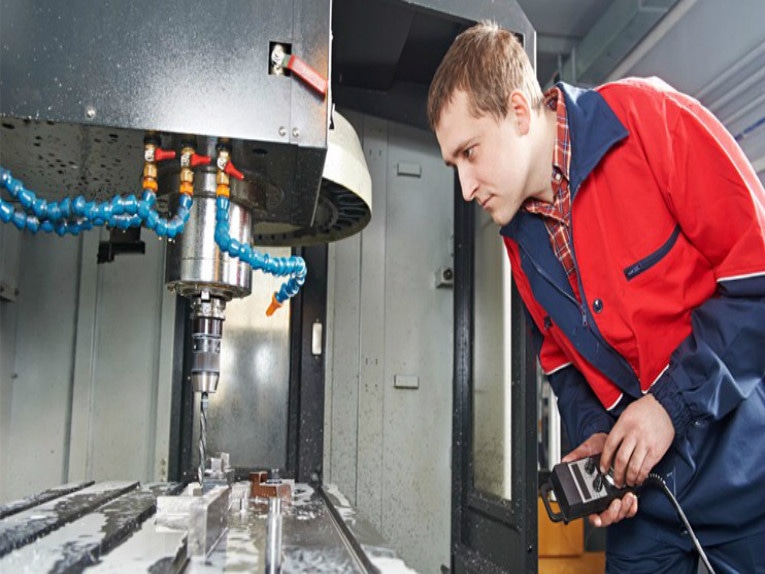Main Drives
Main drives are predominantly closed-loop controlled, electric synchronous, and asynchronous motors. Their applications include kit or housed motors for use in turning, milling and grinding machines as well as in machining centers. The traditional spindle drives with housed motors – mostly air-cooled – are also popular as main drives. In comparison with motor spindles they are less costly when considering the secondary costs of both systems. On the one hand, the interposition of gearboxes enables the rotational speed and torque to be tuned to the machining task. On the other hand the gear boxes cause unwanted radial forces, noise and increased wear.
Those main drives using kit motors with an integrated spindle have become technically sophisticated. Since gearboxes and clutches can be eliminated, these drives make a centric rotational movement possible without suffering from shearing force. They stand out thanks to their long-term running smoothness and minimal wear and are often used for high performance machining. The generation of drives with higher torques is currently still quite costly, since either a (planetary) gear has to be integrated into the spindle or a higher motor power must be selected. To carry out preventive maintenance and servicing, sensors should be integrated into the spindle to monitor and acquire measurement data. Cooling with oil, air or glycol is still necessary.
Feed drives
For feed drives, the choice is between electromechanical or hydraulic systems. In the case of the electromechanical feed drives the electric servomotor with ball-screw assembly currently dominates worldwide. It converts the rotational movement into a linear movement. Here synchronous housed motors are preferred, as they need to cope with high requirements in terms of positioning, synchronized operation and dynamics; more so than the main drive.
Due to its high static rigidity this traditional drive system suits a variety of applications, but it is prone to wear. Depending on installation conditions and the required torque strengths, the servomotor is connected to the spindle either directly or, for example, by way of a synchronous belt.
Drives should offer resistance to wear, as well as high rigidity and dynamics. Such a combination of characteristics enables higher precision and long-term trouble free operation than that obtainable with a comparable ball-screw assembly with indirect position measuring system.
The load regime of the drive is one aspect limiting its use. Of course this does not mean that, when processing with large forces, ball screw assemblies and hydraulic drive solutions can be eliminated. Supporting machine elements such as the swarf cover with its maximum permissible sliding speed and the carriage guide with its damping behavior can also limit application. The benefits of linear motor drives are counteracted by the associated investment costs, which have so far prevented a worldwide breakthrough of this drive technology.
Hydraulic feed drives are in demand when their benefits have a significant impact, such as in confined spaces, as well as those applications that require high dynamics and large feed forces. And, of course, the hydraulic feed drive needs to position accurately to the micrometer. Practical applications demonstrate that the hydraulic linear drive works free of play, is long lasting and tends to be more durable than a comparable drive with ball-screw assembly. With electric feed drives each specific performance (torque and rotational speed) must be installed. A hydraulic axis, however, can draw energy according to demand from a hydraulic fluid accumulator, reducing installed input power by up to 80%.
Auxiliary drives
A variety of drives meet the capabilities needed in an auxiliary drive application. Across the spectrum of auxiliary drive functions in machine tools there is neither a significant trend, nor do certain tried-and-tested units stand out. The choice will depend on the application.
It is not unusual for one machine group with a closed sequence of functions to combine a variety of drives. There are examples of this in applications where electromechanical drives for vertically or diagonally moved carriages are used in combination with hydraulic or pneumatic weight compensation. Here, the weight compensation can be understood as a passive auxiliary drive in the widest sense, its task being to compensate the weight force of the moved mass. Weight compensation can be achieved in a number of ways, the hydraulic system with a hydraulic fluid accumulator being popular. If the weight force that needs compensation is small, a pneumatic gas spring can carry out the function. The advantages of these solutions lie in their adaptable dynamic behavior as well as their favorable energy balance.
Pneumatic drives are ideal for use in handling devices thanks to their low weight, simple control structure and the rapidity of their movements. These features apply to feed and load units for smaller masses, which are integrated into the workpiece flow of the production process. Tool and workpiece clamping on machine tools is critical, as it influences operation accuracy and repeatability. Hydraulic clamps represent a special type of auxiliary drive and are used in machines with unattended workpiece load and unload, thanks to the fact that they are easily automated. The high force density of the clamping elements favors the construction of clamping devices in the smallest spaces.
Conclusion
There is a range of electric, hydraulic, electromechanical and pneumatic drive concepts available as solutions to drive tasks in machine tools. The engineering team needs to decide which type of drive concept is right for the task, taking into account a range of constraints. A good automation supplier who has expertise in all of these technology groups will consider and advise customers in these decisions.
Post time: Jan-20-2020








